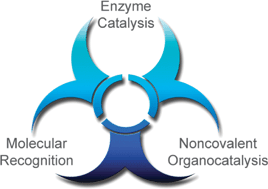(Thio)urea organocatalysis—What can be learnt from anion recognition?
Abstract
The present critical review outlines the close relationship and mutual interplay between molecular recognition, active site considerations in enzyme catalysis involving anions, and organocatalysis utilizing explicit hydrogen bonding. These interconnections are generally not made although, as we demonstrate, they are quite apparent as exemplified with pertinent examples in the field of (thio)urea organocatalysis. Indeed, the concepts of anion binding or binding with negatively (partially) charged heteroatoms is key for designing new organocatalytic transformations. Utilizing anions through recognition with hydrogen-bonding organocatalysts is still in its infancy but bears great potential. In turn, the discovery and mechanistic elucidation of such reactions is likely to improve the understanding of enzyme active sites (108 references).


 Please wait while we load your content...
Please wait while we load your content...